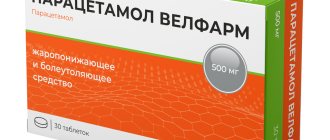Instructions for use PARACETAMOL
IV in the form of infusion.
Paracetamol for infusion is used to quickly relieve pain and/or hyperthermic syndrome, when only intravenous administration of the drug is required. The IV duration is 15 minutes.
| Patient's body weight | Dose per administration | Volume for injection | Maximum volume of paracetamol for infusion (10 mg/ml) per administration, which is based on the upper body weight limits of the patient group (ml)*** | Maximum daily dose ** |
| ≤ 10 kg* | 7.5 mg/kg | 0.75 ml/kg | 7.5 ml | 30 mg/kg |
| > 10 kg to ≤ 33 kg | 15 mg/kg | 1.5 ml/kg | 49.5 ml | 60 mg/kg not more than 2 g |
| > 33kg to ≤ 50kg | 15 mg/kg | 1.5 ml/kg | 75 ml | 60 mg/kg not more than 3 g |
| > 50 kg with additional risk factors for hepatotoxicity | 1 g | 100 ml | 100 ml | 3 g |
| > 50 kg and without additional risk factors for hepatotoxicity | 1 g | 100 ml | 100 ml | 4 g |
* Premature newborns:
there are no data on safety and effectiveness in this category of patients.
**Maximum daily dose.
The maximum daily dose for patients not receiving other drugs containing paracetamol, or the dose should be adjusted accordingly to take into account the use of paracetamol-containing drugs.
***Patients with lower body weight require less paracetamol.
The minimum interval between each administration of the drug should be at least 4 hours.
The minimum interval between each administration of the drug in patients with severe renal failure should be at least 6 hours.
No more than 4 doses can be administered within 24 hours.
In patients with severe renal failure (creatinine clearance <30 ml/min)
It is recommended to increase the minimum interval between each administration to 6 hours.
In adults with hepatocellular insufficiency, chronic alcoholism, chronic malnutrition (low hepatic glutathione reserves),
dehydration, the maximum daily dose should not exceed 3 g.
Patients weighing ≤10 kg:
a ready-made solution for infusion of 10 mg/ml in polymer containers is not suitable for administration to this group of patients, because it does not provide a 15-minute administration.
The volume of solution of 10 mg/ml required for administration should be taken from a polymer container and diluted in 0.9% sodium chloride solution or 5% glucose solution to one tenth (1 volume of paracetamol solution 10 mg/ml per 9 volumes of diluent) and administered within 15 min. To measure the required volume of solution according to the child’s body weight, 5 or 10 ml syringes should be used. However, the volume should never exceed 7.5 ml per administration.
For correct dosage of the drug, you should use the instructions for use.
As with all infusion solutions that are supplied in polymer containers, it should be remembered that the infusion process must be carefully monitored, especially at the end. Such monitoring at the end of the infusion is required to avoid air embolism.
Features of application
Caution should be used when prescribing and administering paracetamol for infusion to avoid dosing errors due to confusion between milligrams (mg) and milliliters (ml), which may lead to accidental overdose and death. Take care to ensure proper dose. When filling out prescriptions, it is necessary to include both the total dose in mg and the total volume of the prescribed solution. It is necessary to monitor the accuracy of dosing.
Compound
Paracetamol is a white tablet, sometimes with a creamy tint. In addition, there is also syrup, which is often prescribed to small children.
One tablet of the drug contains either 200 or 500 mg of paracetamol as a chemical substance (depending on the dosage). The drug also contains auxiliary compounds, for example, potato starch, povidone, stearic acid, and croscarmellose sodium.
Pregnancy and lactation
The use of Paracetamol during pregnancy is justified if the potential benefit to the mother outweighs the risk to the health of the fetus. During the period of active breastfeeding, the mother is not prohibited from taking Paracetamol. It has been proven that the medicinal compound passes into breast milk in very small quantities, which does not affect the baby’s health. In addition, published data regarding the use of Paracetamol during lactation indicate that breastfeeding is not a contraindication for taking the drug.
Reviews
As soon as the temperature starts to rise, I take Paracetamol, and its rise immediately slows down. An effective and inexpensive product!
I always use Paracetamol if I feel like I'm starting to get sick. It reduces the temperature perfectly, and if you need to reduce it again, the drug can be taken every 4 hours.
I like the price of Paracetamol. The drug is absolutely accessible to all people due to its low price.
Side effects
The instructions indicate that some adverse reactions may occur in response to taking the drug.
On the part of the immune system, a person may notice hypersensitivity skin reactions. Local inflammation, redness, and rash may occur after taking the drug. In more severe situations, an anaphylactic reaction occurs, accompanied by Quincke's edema and Stevens-Johnson syndrome. In this case, toxic epidermal necrolysis may occur as a skin manifestation. A pronounced reaction of the immune system, in particular the occurrence of anaphylactic shock, is often associated with a person’s allergy to the drug. Therefore, it is very important to find out in time whether there is a history of allergic reactions in order to promptly prevent the development of anaphylaxis.
On the part of the hematopoietic organs, anemia may develop as a side reaction. Anemic syndrome is a condition based on a decrease in the number of red blood cells and/or hemoglobin in the patient’s blood. Sometimes thrombocytopenia occurs (a decrease in the number of platelets - the cells responsible for the formation of blood clots). In this case, the patient may notice frequent and intense bleeding (for example, nosebleeds) that do not stop for a long time. This is due to a decrease in platelet count: it takes longer for a blood clot to form. Methemoglobinemia and agranulocytosis are likely to occur, which are quite specific side effects and require immediate discontinuation of the drug. Changes in the circulatory system can be noticed both by clinical signs (for example, with anemia, the patient experiences pallor, drowsiness, lethargy, hemorrhagic manifestations are possible) and by laboratory data. The determining factor here is a general and biochemical analysis of the patient’s blood, where a complete picture of the state of various human blood cells will be visible.
On the part of the respiratory system, the occurrence of bronchospasm was observed in those patients who had already noted increased sensitivity to other non-steroidal anti-inflammatory drugs (for example, aspirin). Bronchospasm is associated with a hypersensitivity reaction of the body, and if, after taking Paracetamol tablets, the patient complains of difficulty breathing or shortness of breath, the drug should be immediately noted and the hypersensitivity phenomenon should be stopped.
On the part of the liver, in some rare cases, the development of acute liver failure has been observed. Due to the metabolism of the drug in the liver, as well as the detoxification function of the liver, you should be careful about the state of the hepatobiliary system during Paracetamol therapy. There have been isolated cases that required liver transplantation after active and long-term use of Paracetamol: probably, patients took this non-steroidal anti-inflammatory drug for a long time, which led to the formation of drug-induced hepatitis, or even cirrhosis of the liver.
All patients taking Paracetamol tablets or Paracetamol syrup should remember: the occurrence of any adverse reactions listed in this section or other nonspecific manifestations while taking the drug must be reported to your doctor! The doctor will adjust the dose of Paracetamol or select another drug on an individual basis.
Pharmacodynamics
The drug belongs to the group of non-narcotic analgesics - the drug has an analgesic effect. Paracetamol has a pronounced antipyretic and analgesic effect. The biochemical basis of these reactions is inhibition of cyclooxygenase (one of the leading enzymes responsible for the synthesis of prostaglandins - mediators of inflammation).
Thus, the synthesis of prostaglandins is inhibited in the nervous system, which, moreover, have a pyrogenic effect (leading to an increase in temperature) on the hypothalamus, where the thermoregulation center is located. The hypothalamus is a brain structure responsible for both maintaining the required body temperature and producing certain hormonal factors. Inhibition of prostaglandin synthesis leads to a decrease in their pyrogenic effect on the hypothalamus, heat transfer from the body increases, and temperature decreases.
In parallel, Paracetamol affects the conduction of pain sensitivity impulses along afferent nerve fibers. This mechanism of action provides an analgesic effect.
Research is being conducted on the effect of Paracetamol on the serotonin system, as well as cannabinoid transmission in the brain.
Indications and contraindications for use
Systemic use of Paracetamol by a patient is possible only with a prescription from the attending physician. Self-medication is strictly prohibited, because the drug has both strict indications for use and a number of contraindications.
Paracetamol is a symptomatic remedy. The drug reduces the severity of some symptoms without affecting the actual cause of their occurrence.
Indications for use
| Indications for use | Decoding |
| Different types of pain | Paracetamol is effective for eliminating headaches, dental pain, muscle pain, and discomfort during the menstrual cycle. In addition, the drug is prescribed for the initial stages of arthritis in patients to relieve joint pain. Paracetamol has a moderate analgesic effect, which explains its use in the presence of mild pain. |
| Feverish conditions | Provides relief of fever as a symptom of acute respiratory viral infections, influenza, and other infectious diseases accompanied by an increase in body temperature. The drug is able to effectively reduce body temperature and alleviate the patient's condition. |
Contraindications for use
| Contraindication for use | Decoding |
| Presence of hypersensitivity to one or more components of the drug | The use of Paracetamol is prohibited in patients with episodes of allergic reactions after taking the drug. With repeated use, severe hypersensitivity reactions may develop, including the development of anaphylactic shock. |
| Children under 6 years old | The age-related contraindication to Paracetamol therapy also cannot be ignored: taking the drug in childhood is not allowed. |
| Combinations with other medicinal compounds containing paracetamol | It is prohibited to take Paracetamol while using certain other medications that contain the chemical compound “paracetamol” as an active ingredient. Often, medications to eliminate some symptoms of infectious diseases contain paracetamol. When taking Paracetamol tablets and other substances containing paracetamol, the side effects of the drugs may increase. |
| Liver diseases | The drug should be used with caution in patients with liver diseases, for example: benign hyperbilirubinemia, viral hepatitis, alcoholic liver damage. This is due to impaired liver detoxification function. |
| Pregnancy and lactation period | The drug should be used as carefully as possible during pregnancy and breastfeeding. The dosage should be selected individually with your doctor. |
| Elderly age | Warning when using Paracetamol in old age is associated with physiological changes in metabolism in the body of an elderly person, which also requires careful adjustment of the dosage of the drug. |



